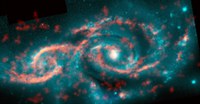A Tsunami of Stars & Gas
 ALMA observations in the 12CO J=1-0 line of the interacting galaxy pair IC 2163 and NGC 2207 at 2 x 1.5 arcsec resolution reveal how the encounter drives gas to pile up in narrow, ~1 kiloparsec wide, "eyelids" in IC 2163. IC 2163 and NGC 2207 are involved in a grazing encounter, which has led to the development in IC 2163 of an eye-shaped (ocular) structure at mid-radius and two tidal arms. The CO data show that there are large velocity gradients across the width of each eyelid, with a mixture of radial and azimuthal streaming of gas at the outer edge of the eyelid relative to its inner edge. The sense of the radial streaming in the eyelids is consistent with the idea that gas from the outer part of IC 2163 flows inward until its radial streaming slows down abruptly and the gas piles up in the eyelids. The radial compression at the eyelids causes an increase in the gas column density by direct radial impact and also leads to a high rate of shear. A linear regression of the molecular column density N(H2) on the magnitude of |dn/dR| across the width of the eyelid at fixed values of azimuth finds a strong correlation between N(H2) and |dn/dR|. Substantial portions of the eyelids have high velocity dispersion in CO, indicative of elevated turbulence there.
ALMA observations in the 12CO J=1-0 line of the interacting galaxy pair IC 2163 and NGC 2207 at 2 x 1.5 arcsec resolution reveal how the encounter drives gas to pile up in narrow, ~1 kiloparsec wide, "eyelids" in IC 2163. IC 2163 and NGC 2207 are involved in a grazing encounter, which has led to the development in IC 2163 of an eye-shaped (ocular) structure at mid-radius and two tidal arms. The CO data show that there are large velocity gradients across the width of each eyelid, with a mixture of radial and azimuthal streaming of gas at the outer edge of the eyelid relative to its inner edge. The sense of the radial streaming in the eyelids is consistent with the idea that gas from the outer part of IC 2163 flows inward until its radial streaming slows down abruptly and the gas piles up in the eyelids. The radial compression at the eyelids causes an increase in the gas column density by direct radial impact and also leads to a high rate of shear. A linear regression of the molecular column density N(H2) on the magnitude of |dn/dR| across the width of the eyelid at fixed values of azimuth finds a strong correlation between N(H2) and |dn/dR|. Substantial portions of the eyelids have high velocity dispersion in CO, indicative of elevated turbulence there.
Image: Dazzling eyelid-like features bursting with stars in galaxy IC 2163 formed from a tsunami of stars and gas triggered by a glancing collision with galaxy NGC 2207 (a portion of its spiral arm is shown on right side of image). ALMA image of carbon monoxide (orange), which revealed motion of the gas in these features, is shown on top of Hubble image (blue) of the galaxy.
Science Team: Michele Kaufman (Newton), Bruce G. Elmegreen (IBM Research), Curtis Struck (Iowa State), Debra Meloy Elmegreen (Vassar), Frédéric Bournaud (CEA Saclay), Elias Brinks (Hertfordshire), Stephanie Juneau (CEA Saclay), and Kartik Sheth (NASA)
Publication: Ocular Shock Front in the Colliding Galaxy IC 2163, 2016, Astrophysical Journal, 831, 161.




Connect with NRAO